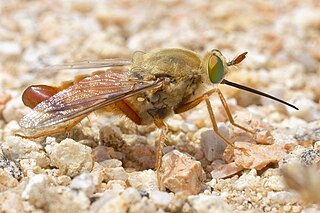
The Mydidae, or Mydas flies, are a cosmopolitan family of flies. It is a small family, with about 471 species described. They are generally large in size, including the largest known fly, Gauromydas heros. Many of the species, in addition to their large size, are mimics of stinging hymenopterans, especially wasps.

The mydid fly genus Rhaphiomidas contains fewer than 30 species/subspecies, all of them occurring in the desert regions of the southwestern United States and adjacent portions of northwestern Mexico. The adults are most commonly encountered in sand dune areas, and are typically only active for a few weeks each year, either in the spring or the fall; in some cases, more than one species can occur in the same dune system, but they are allochronic, each flying in different seasons. Almost nothing is known about their biology, though eggs or early instar larvae of some species are laid on the soil surface and appear to be attractive to ants, and are brought into the ant nest. The restriction to sand dune areas has unfortunately led a number of these flies to the brink of extinction, especially both subspecies of R. terminatus, and the species R. trochilus. While there is only one of these on the Endangered Species List, many of the remaining taxa - including a few that have not yet been named - are gravely imperiled, as they are restricted to small geographic areas, rendering them extremely vulnerable to habitat loss or disturbance. These habitats are heavily targeted for development, and even if not, activities such as sand mining or motorized off-roading are common, and render the habitat unsuitable for the survival of the flies.
Mitrodetus australis is a species of mydas flies in the family Mydidae.
Rhaphiomidas nigricaudis is a species of mydas flies.

Leptomydinae is a subfamily of mydas flies in the family Mydidae primarily distributed in the Northern Hemisphere.
Rhaphiomidas parkeri is a species of mydas flies.
Rhaphiomidas aitkeni is a species of mydas flies.

Mydas maculiventris is a species of mydas flies in the family Mydidae.
Phyllomydas currani is a species of mydas flies.
Heteromydas bicolor is a species of mydas flies in the family Mydidae.
Pseudonomoneura hirta is a species of mydas flies.
Pseudonomoneura is a genus of flies in the family Mydidae.

Rhaphiomidas terminatus, the flower-loving fly, is a species of mydas fly. It is endemic to California.

Phyllomydas quercus is a species of Mydas fly in the family Mydidae.
Pseudonomoneura micheneri is a species of mydas flies.
Nemomydas tenuipes is a species of mydas flies in the family Mydidae.
Pseudonomoneura californica is a species of mydas flies.
Rhaphiomidas maehleri is a species of mydas flies.
Rhaphiomidas painteri is a species of mydas flies.
Rhaphiomidas socorroae is a species of mydas flies.






